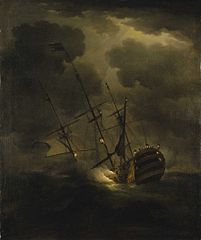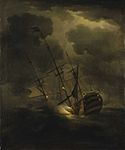HMS Victory (1737)
 HMS Victory tonący w sztormie | |
| Historia | |
| Stocznia | Portsmouth Dockyard |
|---|---|
| Położenie stępki | |
| Wodowanie | |
| Wejście do służby | |
| Zatonął | 4/5 października 1744 |
| Dane taktyczno-techniczne | |
| Wyporność | 1921 ton BM |
| Długość | 53 m |
| Szerokość | 15,0 m |
| Zanurzenie | 5,5 m |
| Uzbrojenie | |
| 100 dział: 28 dział 42-funtowych 28 dział 24-funtowych 28 dział 12-funtowych 12 dział 6-funtowych 4 działa 6-funtowe | |
| Załoga | 900 |
HMS Victory – żaglowy okręt liniowy brytyjskiej marynarki wojennej zbudowany w latach 1726-37 w stoczni Portsmouth Dockyard.
Zatonął w sztormie z całą załogą w nocy 4/5 października 1744 na wodach kanału La Manche (pozycja 49° 42′ 30″ N, 3° 33′ 18″ W). Wrak odnaleziono w 2008. Leży na głębokości 80 m[1].
Okręt przewoził dużą ilość złota, według doniesień gazet o zatonięciu mogło to być nawet 4 tony, dziś warte około 200 milionów dolarów.
Wraz z okrętem zginął admirał John Balchen[2].
Przypisy
- ↑ BBC NEWS | Europe | Legendary British warship 'found', news.bbc.co.uk [dostęp 2017-11-23] (ang.).
- ↑ The Life of Sir John Balchen
Media użyte na tej stronie
Peter Monamy was one of the first English artists to establish a native school of marine painting. His work is often alleged to "show an overwhelming influence of the Dutch style", but the authentic works created by him during his 45 year London career convincingly demonstrate that this influence was a great deal less than "overwhelming". In 1696 Monamy, aged 15, was bound apprentice for seven years to a former Master of the Painter-Stainer's Company, and was obviously trained and taught by him. It has repeatedly been asserted that he "may have" worked in van de Velde’s studio in Greenwich, but there is no evidence whatsoever of this supposed employment. Any such employment is exceedingly unlikely, and in fact virtually impossible. The van de Veldes ceased to maintain a studio in Greenwich soon after the 1689 Revolution of William III, and apparently moved their business to Covent Garden. At this time Monamy was 8-10 years old.
The Loss of the 'Victory', 4 October 1744, is a dramatic night scene in the native English taste. It is highly atmospheric, slightly naive, and discernibly unlike anything by the van de Veldes. The ship was recognized in her day as ‘the finest ship in the world’, but was wrecked and lost with all hands on the Caskets, near the island of Alderney in the English Channel after becoming separated from the rest of the English fleet in a gale.

